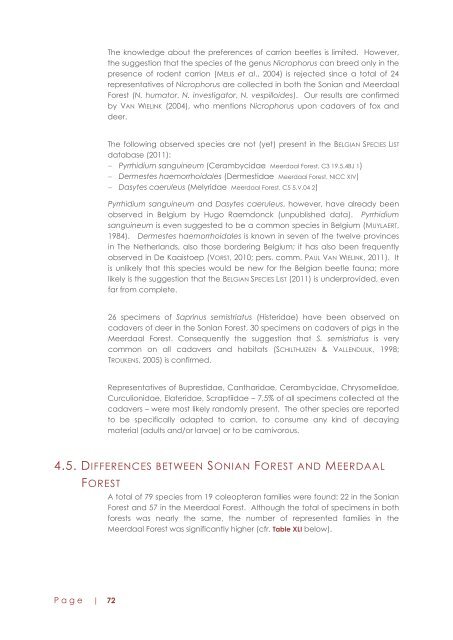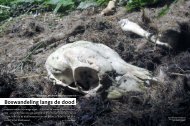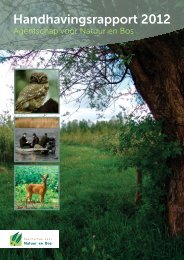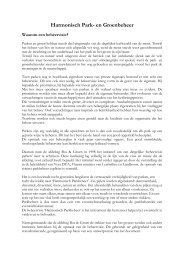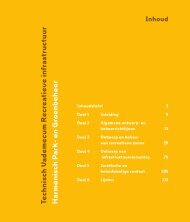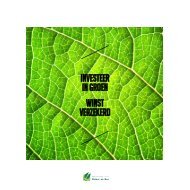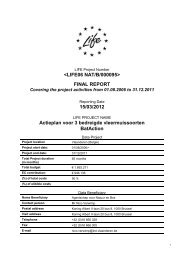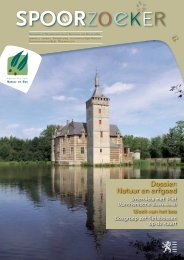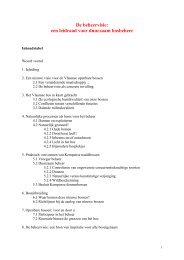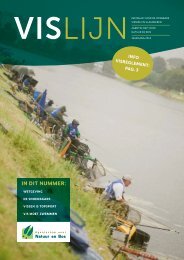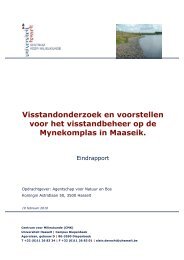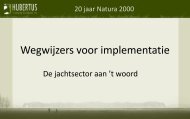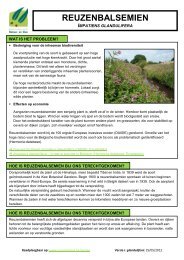Peyritschiella princeps (Thaxt.) I.I. Tav.Peyritschiella protea Thaxt.Rhadinomyces cristatus (Thaxt.)Rhadinomyces pallidus Thaxt.Symplectromyces vulgaris (Thaxt.) Thaxt.Philonthus politusAnotylus rugosusLathrobium brunnipes, castaneip<strong>en</strong>ne, fulvip<strong>en</strong>ne,geminumLathrobium brunnipesPhilonthus sp.Lathrobium brunnipes has be<strong>en</strong> recorded several times in Belgium (C RÊVECOEURet al., 2004), also parasitized ones: infections with Euzodiomyces lathrobii andRhadinomyces cristatus (D E K ESEL & H AGHEBAERT , 1991; D E K ESEL , 1997). However,no Lathrobium brunnipes specim<strong>en</strong>s infected with Rhadinomyces pallidushave yet be<strong>en</strong> found in Belgium.Important to m<strong>en</strong>tion is that cadavers are ephemeral substrates (cfr. 1.2.2. T HE„ ROTTING ‟ OF A CADAVER ). The time for coleopterans to arrive at the cadaver,develop and form new g<strong>en</strong>erations is not long <strong>en</strong>ough in order to form stablepopulations.The CDI (cfr. 1.2.2.3. The early decomposition) of the late decomposition stagedisplays increasing soil carbon and nutri<strong>en</strong>ts compared to the earlydecomposition stage. This CDI composition thus changes during the differ<strong>en</strong>tstages of the „rotting‟ of a cadaver. This effect may exacerbate the inability todevelop stable beetle populations. The species of beetles in the studied areasbelong to differ<strong>en</strong>t ph<strong>en</strong>ology and g<strong>en</strong>eration groups, which means that thespecies composition is able to change during the differ<strong>en</strong>t stages ofdecomposition. Species characteristic of the bloat stage are replaced byother species in the early decomposition and ev<strong>en</strong> others in the latedecomposition.A number of these coleopterans has also be<strong>en</strong> observed in plant remains,rotting fruiting bodies of fungi, animal and human feces, decomposing wood,all ephemeral substrates. This is indeed the case for the species ofLaboulb<strong>en</strong>iales on carrion beetles reported by M AJEWSKI (2003).Carrion beetles have all kind of differ<strong>en</strong>t habitats (see above), includinghibernation sites, suggesting the difficulty for Laboulb<strong>en</strong>iales to adapt tocarrion beetles, since Laboulb<strong>en</strong>iales have their own <strong>en</strong>vironm<strong>en</strong>talprefer<strong>en</strong>ces (DE KESEL, 1996).4.4. SPECIES WORTH MENTIONINGThe carrion beetle Necrodes littoralis has be<strong>en</strong> suggested to occur upon acadaver for only a short time (VAN WIELINK, 2004). However, observations at theMeerdaal Forest are inconsist<strong>en</strong>t with this hypothesis. Necrodes littoralis hasbe<strong>en</strong> recorded upon cadaver 4 in October 2003 (19 larvae) and July 2004 (1adult specim<strong>en</strong>). According to SCHILTHUIZEN & VALLENDUUK (1998) this speciesoccurs on cadavers of rabbit, dog, goat, deer, sheep, fish and chick<strong>en</strong>.The curr<strong>en</strong>t research adds cadavers of pig to that list, regarding the records inthe Meerdaal Forest. The adults of Necrodes littoralis are nocturnal. Collectionof coleopterans happ<strong>en</strong>ed during daylight, which can be the explanation ofthe fact that only one adult specim<strong>en</strong> was found upon cadaver 4.P a g e | 71
The knowledge about the prefer<strong>en</strong>ces of carrion beetles is limited. However,the suggestion that the species of the g<strong>en</strong>us Nicrophorus can breed only in thepres<strong>en</strong>ce of rod<strong>en</strong>t carrion (MELIS et al., 2004) is rejected since a total of 24repres<strong>en</strong>tatives of Nicrophorus are collected in both the Sonian and MeerdaalForest (N. humator, N. investigator, N. vespilloides). Our results are confirmedby VAN WIELINK (2004), who m<strong>en</strong>tions Nicrophorus upon cadavers of fox anddeer.The following observed species are not (yet) pres<strong>en</strong>t in the BELGIAN SPECIES LISTdatabase (2011):Pyrrhidium sanguineum (Cerambycidae Meerdaal Forest, C3 19.5.4BJ 1)Dermestes haemorrhoidales (Dermestidae Meerdaal Forest, NICC XIV)Dasytes caeruleus (Melyridae Meerdaal Forest, C5 5.V.04 2)Pyrrhidium sanguineum and Dasytes caeruleus, however, have already be<strong>en</strong>observed in Belgium by Hugo Raemdonck (unpublished data). Pyrrhidiumsanguineum is ev<strong>en</strong> suggested to be a common species in Belgium (MUYLAERT,1984). Dermestes haemorrhoidales is known in sev<strong>en</strong> of the twelve provincesin The Netherlands, also those bordering Belgium; it has also be<strong>en</strong> frequ<strong>en</strong>tlyobserved in De Kaaistoep (VORST, 2010; pers. comm. PAUL VAN WIELINK, 2011). Itis unlikely that this species would be new for the Belgian beetle fauna; morelikely is the suggestion that the BELGIAN SPECIES LIST (2011) is underprovided, ev<strong>en</strong>far from complete.26 specim<strong>en</strong>s of Saprinus semistriatus (Histeridae) have be<strong>en</strong> observed oncadavers of deer in the Sonian Forest, 30 specim<strong>en</strong>s on cadavers of pigs in theMeerdaal Forest. Consequ<strong>en</strong>tly the suggestion that S. semistriatus is verycommon on all cadavers and habitats (SCHILTHUIZEN & VALLENDUUK, 1998;TROUKENS, 2005) is confirmed.Repres<strong>en</strong>tatives of Buprestidae, Cantharidae, Cerambycidae, Chrysomelidae,Curculionidae, Elateridae, Scraptiidae – 7,5% of all specim<strong>en</strong>s collected at thecadavers – were most likely randomly pres<strong>en</strong>t. The other species are reportedto be specifically adapted to carrion, to consume any kind of decayingmaterial (adults and/or larvae) or to be carnivorous.4.5. DIFFERENCES BETWEEN SONIAN FOREST AND MEERDAALFORESTA total of 79 species from 19 coleopteran families were found: 22 in the SonianForest and 57 in the Meerdaal Forest. Although the total of specim<strong>en</strong>s in bothforests was nearly the same, the number of repres<strong>en</strong>ted families in theMeerdaal Forest was significantly higher (cfr. Table XLI below).P a g e | 72
- Page 3:
LABOULBENIALESEXPLORING AND TESTING
- Page 7 and 8:
PART IVPRELIMINARY CHECKLIST OF LAB
- Page 9 and 10:
SAMENVATTINGINLEIDINGLaboulbeniales
- Page 11 and 12:
PART IGENERAL INTRODUCTIONTHESIS OU
- Page 13 and 14:
fifth volume, therefore the sixth v
- Page 16 and 17:
1.3.3. THE PERITHECI UMAscospores o
- Page 18 and 19:
The identity of appendages, togethe
- Page 20 and 21:
Figure IV: Position of Laboulbeniom
- Page 22 and 23:
LUMBSCH & HUHNDORF (2007) distingui
- Page 25 and 26: Substrate is the intermediate facto
- Page 27: CAVARA (1899, ref. in BENJAMIN, 197
- Page 35 and 36: 1. INTRODUCTION1.1. DIFFICULTIES FO
- Page 37 and 38: 2. MATERIALS & METHODS2.1. FUNGUS,
- Page 39 and 40: 2.2.6. PROTOCOL V: DIRECT PCROne th
- Page 41 and 42: P a g e | 38chance. Thus, the lower
- Page 43 and 44: coll1133 Laboulbenia collae IV 608l
- Page 45 and 46: Cladosporium (Ascomycota, Dothideom
- Page 47 and 48: 5. CONCLUSION AND SUGGESTIONSMany a
- Page 49 and 50: 1. INTRODUCTION1.1. FORENSIC ENTOMO
- Page 51 and 52: Different groups of carrion beetles
- Page 53 and 54: The 1.319 ha Meerdaal Forest has be
- Page 55 and 56: 2.2. MEERDAAL FOREST(DA TA NA TI O
- Page 57 and 58: approximately 2.700 are found in Eu
- Page 59 and 60: Order ColeopteraSuborder PolyphagaI
- Page 61 and 62: Dermestidae 8 2 23 (3) / 22 (4)Elat
- Page 63 and 64: Table XXIV: Family Cerambycidae fro
- Page 65 and 66: Table XXVIII: Family Dermestidae fr
- Page 67 and 68: Adults prey on other flower-visitin
- Page 69 and 70: Table XXXV: Family Scarabaeidae fro
- Page 71 and 72: Creophilus Samouellemaxillosus (Lin
- Page 73: 4.3. LABOULBENIALES OF CARRION BEET
- Page 77 and 78: Table XLII: Comparison of carrion b
- Page 79 and 80: 5. CONCLUSION AND SUGGESTIONSNo spe
- Page 81 and 82: 1. INTRODUCTION1.1. NATURAL LANDSCA
- Page 83 and 84: In the 40s, Middelhoek studied and
- Page 85 and 86: 2. MATERIALS & METHODS2.1. HOSTS2.1
- Page 87 and 88: Screening of the insects was done w
- Page 89 and 90: 3. RESULTS3.1. PARASITE-HOST LISTA
- Page 91 and 92: Figure XV: Detail of thallus of Lab
- Page 93 and 94: isodiametric or slightly elongate,
- Page 95 and 96: occurs in the lower receptacle (cel
- Page 97 and 98: Discussion:Two species of the genus
- Page 99 and 100: anches (15-)34-38(-40) µm long, te
- Page 101 and 102: 5. CONCLUSION AND SUGGESTIONSIn The
- Page 103 and 104: P a g e | 100ADRIAENS, T. & GYSELS,
- Page 105 and 106: transmission, habitat preference an
- Page 107 and 108: STALPERS, J.A., VILGALYS, R., AIME,
- Page 109 and 110: MELIS, C., TEURLINGS, I. LINNELL, J
- Page 111 and 112: SCHILTHUIZEN, M. & VALLENDUUK, H. (


